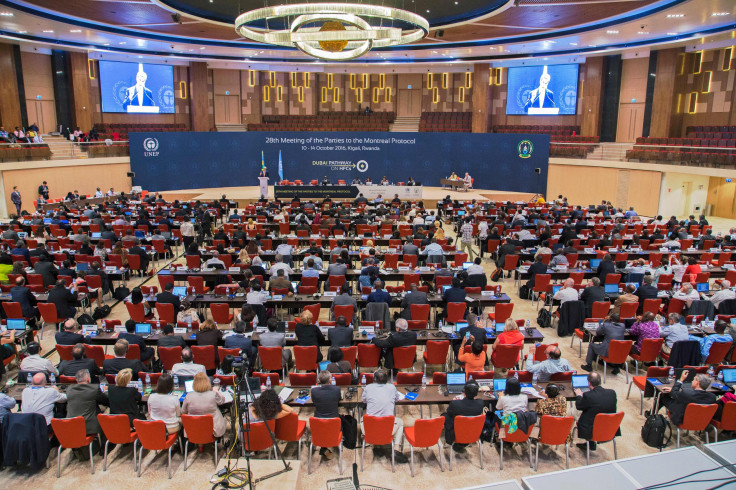Climate Change: HFC Greenhouse Gases To Be Phased Out In Historic Deal

Negotiators from nearly 200 nations have clinched a historic deal to phase down emissions of hydrofluorocarbons (HFCs) — potent greenhouse gases used in air conditioners and refrigerators. The agreement — a major expansion of the 1987 Montreal Protocol, which eliminated the use of the ozone-depleting chlorofluorocarbons — was finalized during a United Nations meeting in Kigali, Rwanda.
The agreement, which established timetables for the signatories to freeze and then reduce HFC emissions, was announced early Saturday after nightlong negotiations.
Under the Kigali amendment, HFCs will now come under the ambit of the Montreal Protocol. Developed nations will begin reducing the use of HFCs incrementally, initially cutting it down by 10 percent by 2019, and by 85 percent by 2036 over a 2011-2013 baseline. Over 100 developing countries, including China, will freeze their HFC use by 2024, while a few other developing nations, including India, will do so by 2028.
“This is a huge win for the climate. We have taken the first concrete step in delivering on the promises we made in Paris last December,” the European Union Commissioner for Climate Action and Energy Miguel Arias Cañete said in a statement. “The global phase-down we have agreed today could knock off up to half a degree of warming by the end of the century.”
If this happens, it would mark the largest temperature reduction ever achieved through a single agreement.
HFCs are currently one of the world’s fastest growing greenhouse gases, and, though their atmospheric concentration is far less than carbon dioxide’s, they pack a much greater warming punch. These gases were introduced as a replacement to the far more dangerous chlorofluorocarbons, which, in addition to being potent greenhouse gases, also damage Earth’s protective ozone layer.
Although HFCs cause a greenhouse effect that’s thousands of times more powerful than carbon dioxide’s, their average atmospheric lifetime is roughly 15 years — unlike carbon dioxide, which can persist in the atmosphere for centuries. As a result, eliminating the use of HFCs under the Kigali amendment can, according to an estimate by the New York-based environmental nonprofit Natural Resources Defense Council (NRDC), prevent emitting the equivalent of more than 80 billion tons of carbon dioxide over the next 35 years.
“This is the biggest step we can take in the year after the Paris agreement, and is equal to stopping the entire world’s fossil-fuel CO2 emissions for more than two years,” David Doniger, NRDC’s climate and clean air program director, said in a statement. “Bringing HFCs under the Montreal Protocol also sends a clear signal to the global marketplace to start replacing these dangerous chemicals with a new generation of climate-friendly and energy-efficient alternatives.”
The Paris climate agreement, finalized last year, will enter into force on Nov. 4. Its long-term goal is to keep the rise in average global temperatures “well below” 2 degrees Celsius (3.6 degrees Fahrenheit) above the pre-industrial levels, and to pursue efforts to keep it within 1.5 degrees Celsius (2.7 degrees Fahrenheit).
"The Kigali Amendment, with the Paris Agreement, gives 2016 the biggest one-two punch in the history of battling global warming," Alexander von Bismarck, the executive director of the Environmental Investigation Agency, said in a statement. "Still, with billions of tonnes of emissions left untouched, the ultimate power of the Kigali amendment now depends on accelerating the removal of these industrial climate-killers in upcoming meetings."
© Copyright IBTimes 2024. All rights reserved.






















